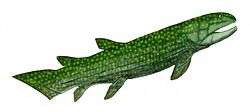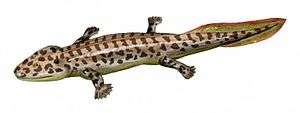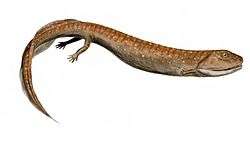Tutusius
Tutusius is a genus of extinct tetrapod from the Devonian of South Africa, containing a single species, Tutusius umlambo. It was described from the +/- 360 myo Gondwana locality of Waterloo Farm lagerstätte on the south-eastern coast of South Africa, which at the time was located within the Antarctic Circle. Together with the find of Umzantsia amazana from the same locality, this provides the first evidence that Devonian tetrapods were not restricted to the tropics as was formerly believed, and suggests that they may have been global in distribution. Waterloo Farm fossils have been metamorphosed and intensely flattened, with the bone tissue replaced by secondary metamorphic mica that is partially altered to kaolinite and chlorite during uplift. They also provide the first evidence of Devonian tetrapods from the continent of Africa, and only the second and third such taxa from Gondwana.[1][2]
| Tutusius | |
|---|---|
1.jpg) | |
| Reconstructed outline | |
| Scientific classification | |
| Kingdom: | Animalia |
| Phylum: | Chordata |
| Clade: | Stegocephalia |
| Genus: | †Tutusius Gess & Alberg, 2018 |
| Type species | |
| †Tutusius umlambo Gess & Ahlberg, 2018 | |
Etymology
The generic name is in honour of Archbishop Desmond Tutu, in recognition of his outstanding contribution to the political and social development of South Africa. The specific name is from isiXhosa “umlambo”, meaning “river”, referring to the depositional environment.[1]
Description
Tutusius is represented by a single bone from the shoulder girdle, the cleithrum. It tapers to a point anteroventrally and carries a single attachment scar for the scapulocoracoid, which extends along the anteroventral process, forms a v-shaped dorsal peak, and ends posteriorly in a projecting buttress. The cleithrum lacks ornament and has a distinct flexure point demarcating the obliquely sloping ventral half of the bone from the more vertical dorsal half. The blade of the cleithrum is broad and thin. It differs from all other tetrapod cleithra in the presence of a projecting posterior flange, with striated texture and a jagged margin, on the middle part of the blade.[1][2]
References
- Gess, R.; Ahlberg, P. E. (2018). "A tetrapod fauna from within the Devonian Antarctic Circle". Science. 360 (6393): 1120–1124. doi:10.1126/science.aaq1645.
- "First tetrapods of Africa lived within the Devonian Antarctic Circle". Johannesburg: University of Witwatersrand. June 2018.






